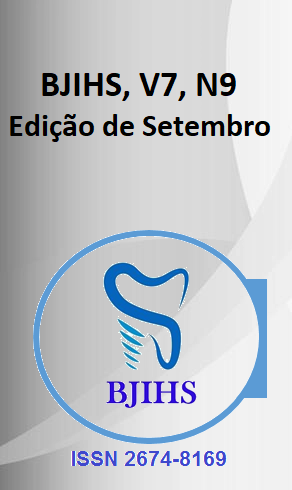Abstract
INTRODUCTION: Acute Kidney Injury (AKI) is a clinical syndrome characterized by a sudden and potentially reversible loss of renal function, being highly prevalent among hospitalized patients, especially those admitted to Intensive Care Units (ICUs). This condition is associated with increased mortality, prolonged hospital stays, and higher healthcare costs. Although classifications such as RIFLE, AKIN, and KDIGO have standardized diagnostic criteria, underreporting remains frequent and compromises clinical management.OBJECTIVES:To review the current scientific literature on Acute Kidney Injury, highlighting risk factors, diagnostic classifications, emerging biomarkers, therapeutic strategies, and prognostic implications.METHODOLOGY:This study consists of a literature review carried out between 2019 and 2024 in the PubMed, SciELO, and LILACS databases. Articles in Portuguese, English, and Spanish were included if they were available in full text and addressed prevalence, diagnosis, treatment, or clinical outcomes of AKI. Studies not directly related to the topic or with low methodological relevance were exclude. RESULTS:The analysis showed that sepsis, hypoperfusion, nephrotoxic drugs, and urinary tract obstruction are the main triggers of AKI. Approximately 70% of patients present partial or total recovery of renal function within 90 days, while 30% progress to chronic kidney disease or require renal replacement therapy. Non-pharmacological strategies, such as infection prevention, hemodynamic optimization, and reduction of nephrotoxic exposure, proved to be essential for prognosis. Biomarkers such as NGAL and KIM-1 are emerging as promising tools for early diagnosis, although they are not yet widely available in clinical practice. CONCLUSION:
AKI remains a major clinical challenge due to its high incidence and prognostic impact. The literature reinforces the need for preventive strategies, standardized clinical protocols, and multiprofessional training. Furthermore, diagnostic advances, such as biomarkers, and therapeutic approaches, such as individualized renal replacement therapy, hold the potential to improve survival and quality of life in affected patients.
References
AL-RAWASHDEH, S. Y. et al. Estudo epidemiológico da lesão renal aguda em unidade de terapia intensiva: evolução e prognóstico. Saudi Journal of Kidney
Diseases and Transplantation, v. 34, n. 2, p. 353-362, 2023. DOI: 10.4103/1319-
352432.
Visão geral da lesão renal aguda: das descobertas básicas às novas estratégias de prevenção e terapia. Pharmacology & Therapeutics, v. 202, p. 107-121, 2019. DOI: 10.1016/j.pharmthera.2019.04.001.
Abordagem atualizada da Lesão Renal Aguda (LRA): uma revisão narrativa. Revista Eletrônica Acervo Médico, v. 2, e10162, 2022. DOI:
25248/reamed.e10162.2022.
Desfechos de Lesão Renal Aguda em Pacientes com COVID-19: Revisão
Sistemática e Metanálise. Jornal Brasileiro de Nefrologia, v. 44, n. 2, p. 180-192, 2022. DOI: 10.1590/2175-8239-JBN-2022-0013pt.
Evolução em Longo Prazo após Episódio de Lesão Renal Aguda – Revisão Narrativa. Jornal Brasileiro de Nefrologia, v. 37, n. 1, p. 87-98, 2015. DOI: 10.5935/0101-2800.20150016.
Uso das Classificações RIFLE e AKIN para Pacientes com Lesão Renal Aguda
Internados em Unidades de Terapia Intensiva: uma revisão integrativa da literatura.
RevistaFT, v. 11, n. 108, p. 1-12, 2021. DOI: 10.69849/revistaft/th102412011108.
Diretrizes atuais para o tratamento da lesão renal aguda. Brazilian Journal of Health Review, v. 6, n. 8, p. 2938-2946, 2024. DOI: 10.36557/2674- 8169.2024v6n8p2938-2946.
Fatores de risco para lesão renal aguda em pacientes clínicos intensivos. Acta Paulista de Enfermagem, v. 33, n. 2, p. 162-171, 2020. DOI: 10.37689/acta- ape/2020AO0064.
Associação da lesão renal aguda com desfechos clínicos de pacientes em
unidade de terapia intensiva. Cogitare Enfermagem, v. 26, p. e73926, 2021. DOI: 10.5380/ce.v26i0.73926.

This work is licensed under a Creative Commons Attribution 4.0 International License.
Copyright (c) 2025 Maria de Moraes Guarçoni Silva Brito, Daniel Ruiz Agum, Emilly da Silva Dela Costa, Maria Nogueira da Costa, Ana Carolina Franskoviak Cunha Silva, Letícia Rodrigues Babinsck, Juliana Machado Sopeletto, Alice Sales zampirolli, Maria Clara Cosseti Gava, Angélica Pimenta do Amaral, Leandro Mendes Zagotto, Giovana Figueira Barbosa, Anitha Coelho Barbosa
